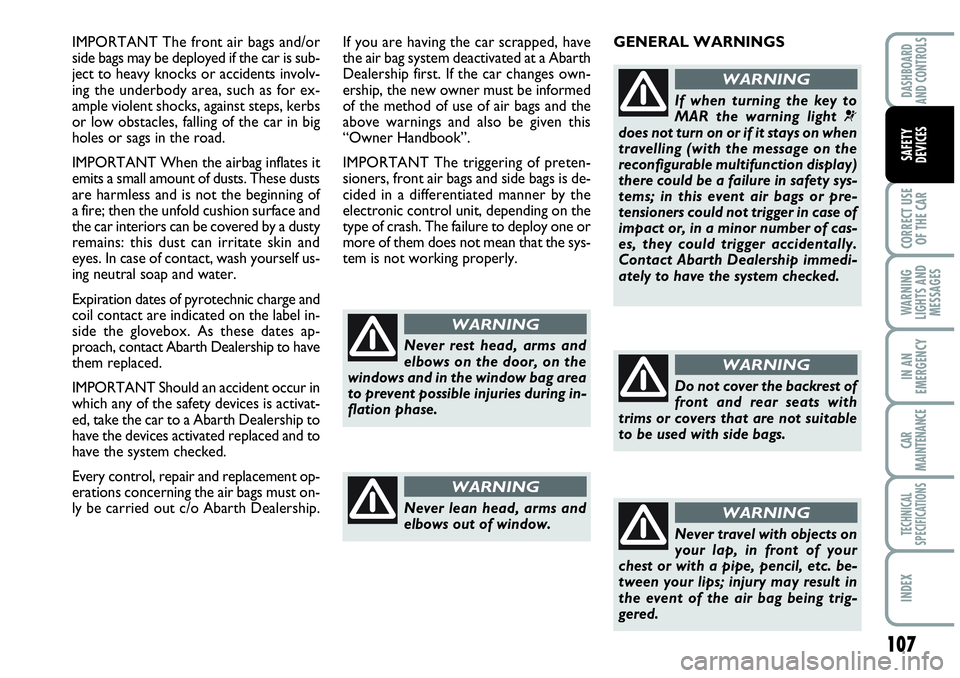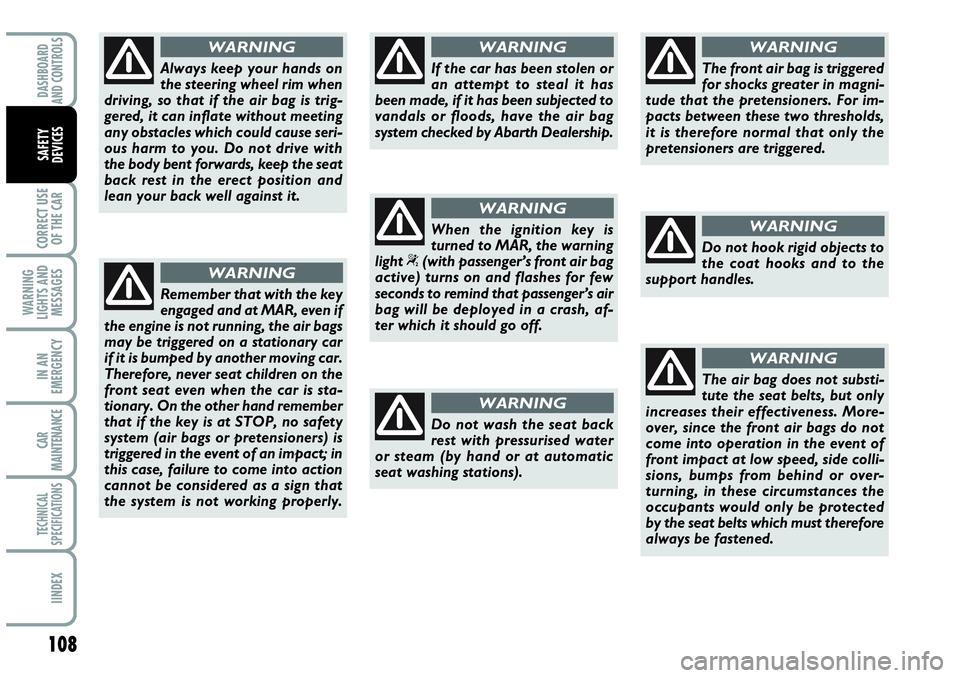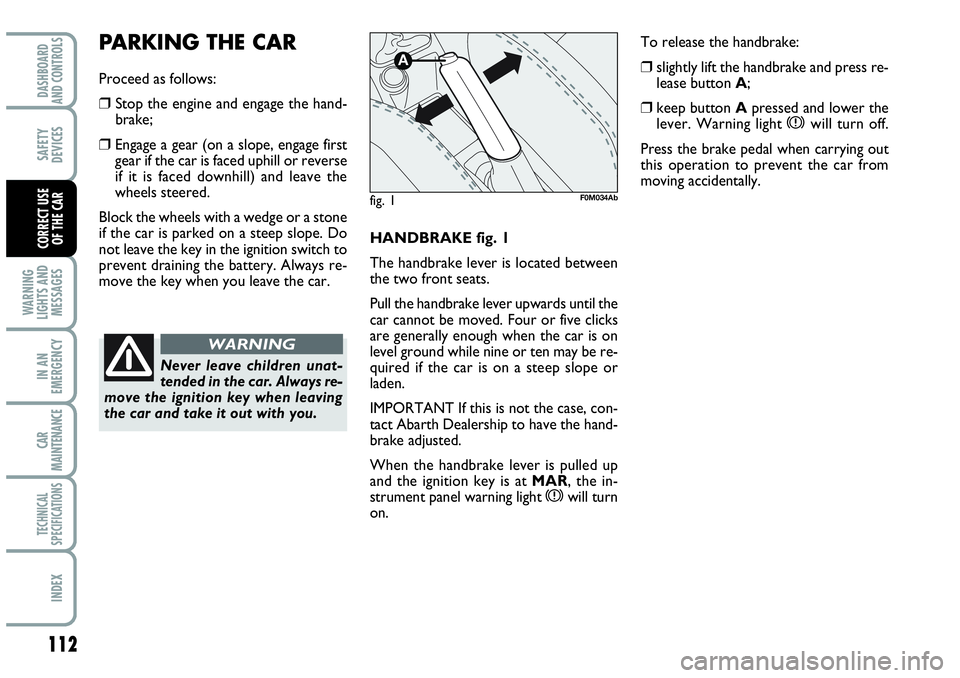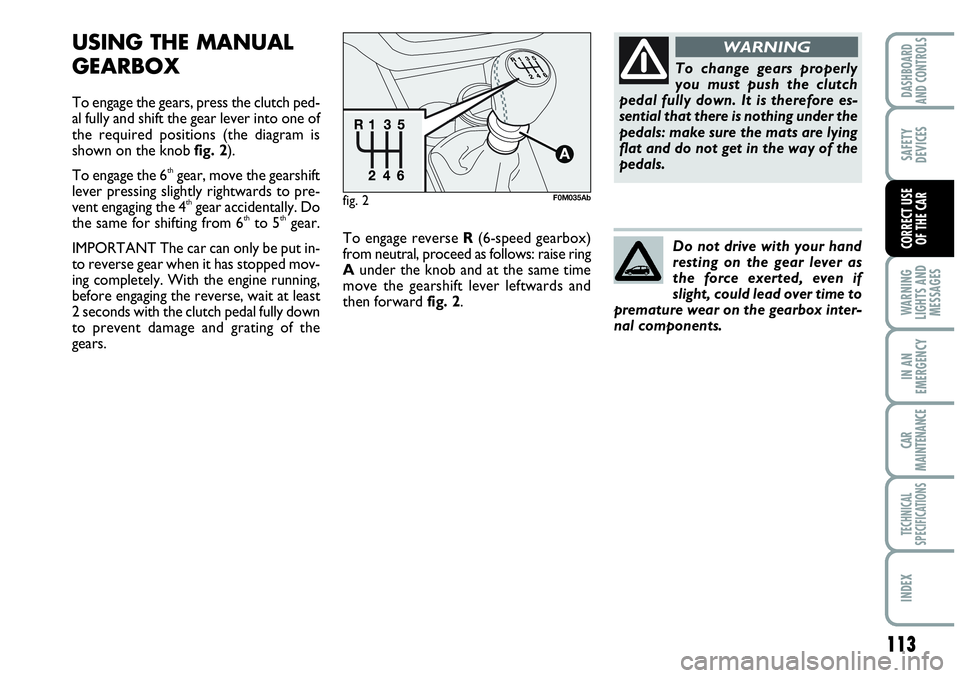technical specifications Abarth Grande Punto 2007 Owner handbook (in English)
[x] Cancel search | Manufacturer: ABARTH, Model Year: 2007, Model line: Grande Punto, Model: Abarth Grande Punto 2007Pages: 207, PDF Size: 3.01 MB
Page 106 of 207

104
CORRECT USE
OF THE CAR
WARNING
LIGHTS AND
MESSAGES
IN AN
EMERGENCY
CAR
MAINTENANCE
TECHNICAL
SPECIFICATIONS
IINDEX
DASHBOARD
AND CONTROLS
SAFETY
DEVICES
PASSENGER’S FRONT AIR BAG
fig. 15
It consists of an instant-inflating cushion
contained into a special recess in the dash-
board, this cushion has a volume bigger
than that of the driver. In minor crashes (for which the restrain-
ing action of the seat belts is sufficient), the
air bags are not deployed. Also in this case
it is of vital importance to wear the seat
belts since in case of side crash they guar-
antee proper positioning of the occupant
and prevent the occupants to be pitched
out of the car in case of violent crashes.
DRIVER’S FRONT AIR BAG fig. 14
It consists of an instant-inflating cushion
contained in a special recess in the cen-
tre of the steering wheel.
Do not apply stickers or oth-
er objects to the steering
wheel or to the air bag cover on the
passenger’s side or on the side roof
lining. Never put objects (e.g. mobile
phones) on the dashboard on pas-
senger side since they could interfere
with proper air bag inflation and al-
so cause serious injury.
WARNINGThe volume of front air bags at max. in-
flation fills most of the space between the
steering wheel and the driver and between
the dashboard and the passenger.
In case of crash, a person not wearing the
seat belt moves forward and may come in-
to contact with the cushion while it is still
inflating. Under this circumstance the pro-
tection offered by the air bag is reduced.
Front air bag may not be activated in the
following situations:
❒in collisions against highly deformable
objects not affecting the car front sur-
face (e.g. bumper collision against guard
rail, etc.);
❒ in case of wedging under other vehicles
or protective barriers (for example un-
der a truck or guard rail), the air bag
is not triggered as it offers no additional
protection compared with the seat
belts, consequently it would be point-
less. Therefore, failure to come into ac-
tion in the above circumstance does
not mean that the system is not work-
ing properly.
fig. 14F0M031Ab
fig. 15F0M032Ab
Page 107 of 207

105
CORRECT USE
OF THE CAR
WARNING
LIGHTS AND
MESSAGES
IN AN
EMERGENCY
CAR
MAINTENANCE
TECHNICAL
SPECIFICATIONS
INDEX
DASHBOARD
AND CONTROLS
SAFETY
DEVICES
MANUAL DEACTIVATION OF
PASSENGER’S FRONT AIR BAG
AND SIDE BAG
(for versions/markets,
where provided)
Should it be absolutely necessary to car-
ry a child on the front seat, the passenger’s
front air bag and the Side Bag (for ver-
sions/markets, where provided) can be de-
activated.
The instrument panel warning light “will
stay on glowing steadily until reactivating
the passenger’s front air bag and the Side
Bag (for versions/markets, where provid-
ed).
SERIOUS DANGER: With
passenger’s air bag active
(ON), never place child’s
seats with the cradle facing
backwards since the air bag
activation could cause to
the child serious injuries, even mortal.
In the case of need, always deactivate
the passenger’s air bag when a child’s
seat is placed on the front seat. The
front passenger’s seat shall be ad-
justed in the most backward position
to prevent any contact between
child’s seat and dashboard. Even if
not compulsory by law, you are rec-
ommended to reactivate the air bag
immediately as soon as child trans-
port is no longer necessary.
WARNING
To deactivate the passen-
ger’s front air bag and the
Side Bag (for versions/markets, where
provided), refer to paragraph “Re-
configurable multifunction display” in
section “Dashboard and controls”.
WARNING
Page 108 of 207

SIDE AIR BAGS
The car is fitted with front side bags for
driver and passenger (for versions/ mar-
kets, where provided) for protecting the
chest and window bags (for versions/ mar-
kets, where provided) for protecting front
and rear passengers’ head.
Side bags (for versions/markets, where
provided) protect car occupants from side
crashes of medium-high severity, by plac-
ing the cushion between the occupant and
the internal parts of the side structure of
the car.
Non-activation of side bags in other types
of collisions (front collisions, rear shunts,
roll-overs, etc...) is not a system malfunc-
tion.
In case of side crash, an electronic control
unit, when required triggers the inflation
of the cushion. The cushion immediately
inflates, placing itself as a protection, be-
tween the occupant’s body and the struc-
ture that could cause injuries. Immediate-
ly after, the cushion deflates.
Side bags (for versions/markets, where
provided) are not a replacement of but
complementary to the belts, which you
are recommended to always wear, as
specified by law in Europe and most non-
European countries.FRONT SIDE BAGS - CHEST
AND PELVIS ZONE
PROTECTION fig. 16
(for versions/markets,
where provided)
Front side bags are housed in the seat back
rests, they consist of an instant inflation
cushion designed to increase protection
of the occupants’ chest and pelvis zone in
the event of a side crash of medium-high
severity.SIDE WINDOW BAGS - HEAD
PROTECTION fig. 17
(for versions/markets,
where provided)
They consist of two “curtain” cushions,
one on the right and the other on the left
side of the car, located behind the side
coverings of the roof and covered by
proper finishing.
Window bags have been designed for pro-
tecting the head of front and rear occu-
pants in the event of side crash, thanks to
the wide cushion inflation surface.
IMPORTANT In the event of side crash,
you can obtain the best protection by the
system keeping a correct position on the
seat, allowing thus a correct window bag
unfolding.
106
CORRECT USE
OF THE CAR
WARNING
LIGHTS AND
MESSAGES
IN AN
EMERGENCY
CAR
MAINTENANCE
TECHNICAL
SPECIFICATIONS
IINDEX
DASHBOARD
AND CONTROLS
SAFETY
DEVICES
fig. 16F0M033Abfig. 17F0M0141m
Page 109 of 207

107
CORRECT USE
OF THE CAR
WARNING
LIGHTS AND
MESSAGES
IN AN
EMERGENCY
CAR
MAINTENANCE
TECHNICAL
SPECIFICATIONS
INDEX
DASHBOARD
AND CONTROLS
SAFETY
DEVICES
IMPORTANT The front air bags and/or
side bags may be deployed if the car is sub-
ject to heavy knocks or accidents involv-
ing the underbody area, such as for ex-
ample violent shocks, against steps, kerbs
or low obstacles, falling of the car in big
holes or sags in the road.
IMPORTANT When the airbag inflates it
emits a small amount of dusts. These dusts
are harmless and is not the beginning of
a fire; then the unfold cushion surface and
the car interiors can be covered by a dusty
remains: this dust can irritate skin and
eyes. In case of contact, wash yourself us-
ing neutral soap and water.
Expiration dates of pyrotechnic charge and
coil contact are indicated on the label in-
side the glovebox. As these dates ap-
proach, contact Abarth Dealership to have
them replaced.
IMPORTANT Should an accident occur in
which any of the safety devices is activat-
ed, take the car to a Abarth Dealership to
have the devices activated replaced and to
have the system checked.
Every control, repair and replacement op-
erations concerning the air bags must on-
ly be carried out c/o Abarth Dealership.If you are having the car scrapped, have
the air bag system deactivated at a Abarth
Dealership first. If the car changes own-
ership, the new owner must be informed
of the method of use of air bags and the
above warnings and also be given this
“Owner Handbook”.
IMPORTANT The triggering of preten-
sioners, front air bags and side bags is de-
cided in a differentiated manner by the
electronic control unit, depending on the
type of crash. The failure to deploy one or
more of them does not mean that the sys-
tem is not working properly.
Never rest head, arms and
elbows on the door, on the
windows and in the window bag area
to prevent possible injuries during in-
flation phase.
WARNING
Never lean head, arms and
elbows out of window.
WARNING
GENERAL WARNINGS
If when turning the key to
MAR the warning light ¬does not turn on or if it stays on when
travelling (with the message on the
reconfigurable multifunction display)
there could be a failure in safety sys-
tems; in this event air bags or pre-
tensioners could not trigger in case of
impact or, in a minor number of cas-
es, they could trigger accidentally.
Contact Abarth Dealership immedi-
ately to have the system checked.
WARNING
Do not cover the backrest of
front and rear seats with
trims or covers that are not suitable
to be used with side bags.
WARNING
Never travel with objects on
your lap, in front of your
chest or with a pipe, pencil, etc. be-
tween your lips; injury may result in
the event of the air bag being trig-
gered.
WARNING
Page 110 of 207

108
CORRECT USE
OF THE CAR
WARNING
LIGHTS AND
MESSAGES
IN AN
EMERGENCY
CAR
MAINTENANCE
TECHNICAL
SPECIFICATIONS
IINDEX
DASHBOARD
AND CONTROLS
SAFETY
DEVICES
Always keep your hands on
the steering wheel rim when
driving, so that if the air bag is trig-
gered, it can inflate without meeting
any obstacles which could cause seri-
ous harm to you. Do not drive with
the body bent forwards, keep the seat
back rest in the erect position and
lean your back well against it.
WARNING
Remember that with the key
engaged and at MAR, even if
the engine is not running, the air bags
may be triggered on a stationary car
if it is bumped by another moving car.
Therefore, never seat children on the
front seat even when the car is sta-
tionary. On the other hand remember
that if the key is at STOP, no safety
system (air bags or pretensioners) is
triggered in the event of an impact; in
this case, failure to come into action
cannot be considered as a sign that
the system is not working properly.
WARNING
Do not wash the seat back
rest with pressurised water
or steam (by hand or at automatic
seat washing stations).
WARNING
The front air bag is triggered
for shocks greater in magni-
tude that the pretensioners. For im-
pacts between these two thresholds,
it is therefore normal that only the
pretensioners are triggered.
WARNING
Do not hook rigid objects to
the coat hooks and to the
support handles.
WARNING
The air bag does not substi-
tute the seat belts, but only
increases their effectiveness. More-
over, since the front air bags do not
come into operation in the event of
front impact at low speed, side colli-
sions, bumps from behind or over-
turning, in these circumstances the
occupants would only be protected
by the seat belts which must therefore
always be fastened.
WARNING
When the ignition key is
turned to MAR, the warning
light “(with passenger’s front air bag
active) turns on and flashes for few
seconds to remind that passenger’s air
bag will be deployed in a crash, af-
ter which it should go off.
WARNING
If the car has been stolen or
an attempt to steal it has
been made, if it has been subjected to
vandals or floods, have the air bag
system checked by Abarth Dealership.
WARNING
Page 111 of 207

109
WARNING
LIGHTS AND
MESSAGES
IN AN
EMERGENCY
CAR
MAINTENANCE
TECHNICAL
SPECIFICATIONS
INDEX
DASHBOARD
AND CONTROLS
SAFETY
DEVICES
CORRECT USE
OF THE CAR
ENGINE STARTING ........................................................... 110
PARKING THE CAR ............................................................ 112
USING THE MANUAL GEARBOX ................................. 113
CONTAINING RUNNING COSTS................................. 114
TOWING TRAILERS............................................................ 116
SNOW CHAINS ................................................................... 119
CAR INACTIVITY ............................................................... 120
C C
O O
R R
R R
E E
C C
T T
U U
S S
E E
O O
F F
T T
H H
E E
C C
A A
R R
Page 112 of 207

110
WARNING
LIGHTS AND
MESSAGES
IN AN
EMERGENCY
CAR
MAINTENANCE
TECHNICAL
SPECIFICATIONS
INDEX
DASHBOARD
AND CONTROLS
SAFETY
DEVICES
CORRECT USE
OF THE CAR
ENGINE STARTING
The car is fitted with an electronic engine
lock device: if the engine fails to start, see
the paragraph “The Fiat CODE system” in
section “Dashboard and controls”.
The engine may be noisier than usual dur-
ing the first seconds of operation, espe-
cially after it has not been used for a while.
This characteristic feature does not com-
promise functionality or reliability of the
hydraulic tappets: the timing system de-
vised to limit servicing.
We recommend that during
the initial period you do not
drive to full car performance
(e.g.: excessive acceleration,
long journeys at top speed, sharp brak-
ing, etc.).
When the engine is switched
off never leave the key into
the ignition switch to prevent
pointless current absorption
from draining the battery.
Running the engine in con-
fined areas is extremely dan-
gerous. The engine consumes oxygen
and produces carbon monoxide
which is a highly toxic and lethal gas.
WARNING
Remember that the servo-
brake and power steering
are not operational until the engine
has been started, therefore much ef-
fort than usual is required on the
brake pedal and steering wheel.
WARNING
Proceed as follows:
❒ensure that the handbrake is up;
❒put the gear lever into neutral;
❒ press the clutch pedal down to the
floor without touching the accelerator;
❒turn the ignition key to AVVand let
it go the moment the engine starts.
If the engine does not start at the first at-
tempt, return the ignition key to STOP
before repeating starting.
If, when the ignition key is at MAR, warn-
ing light
Yremains lit together with
warning light Uturn the key to STOP
STOP and then back to MAR; if the warn-
ing light remains on, try with the other
keys provided with the car.
IMPORTANT If the instrument panel
warning light Ystays on glowing steadi-
ly, contact immediately Abarth Dealership.
IMPORTANT Never leave the ignition key
to MARwhen the engine is off.
Page 113 of 207

111
WARNING
LIGHTS AND
MESSAGES
IN AN
EMERGENCY
CAR
MAINTENANCE
TECHNICAL
SPECIFICATIONS
INDEX
DASHBOARD
AND CONTROLS
SAFETY
DEVICES
CORRECT USE
OF THE CAR
STOPPING THE ENGINE
Turn the ignition to STOPwhile the en-
gine is idling.
IMPORTANT After a taxing drive, you
should allow the engine to “catch its
breath” before turning it off by letting it
idle to allow the temperature in the en-
gine compartment to fall.
A quick burst on the acceler-
ator before turning off the en-
gine serves absolutely no
practical purpose, it wastes
fuel and is damaging especially to tur-
bocharged engines.HOW TO WARM UP THE
ENGINE AFTER IT HAS JUST
STARTED
Proceed as follows:
❒ Drive off slowly, letting the engine turn
at medium revs. Do not accelerate
abruptly;
❒Do not drive at full performance for the
initial kilometres. Wait until the coolant
temperature gauge starts moving.
Remember that the servo-
brake and power steering are
not operational until the en-
gine has been started, there-
fore much effort than usual is required
on the brake pedal and steering wheel.
Never bump start the engine
by pushing, towing or coast-
ing downhill as this could
cause fuel to flow into the
catalytic exhaust system and damage
it beyond repair.
Page 114 of 207

112
WARNING
LIGHTS AND
MESSAGES
IN AN
EMERGENCY
CAR
MAINTENANCE
TECHNICAL
SPECIFICATIONS
INDEX
DASHBOARD
AND CONTROLS
SAFETY
DEVICES
CORRECT USE
OF THE CARHANDBRAKE fig. 1
The handbrake lever is located between
the two front seats.
Pull the handbrake lever upwards until the
car cannot be moved. Four or five clicks
are generally enough when the car is on
level ground while nine or ten may be re-
quired if the car is on a steep slope or
laden.
IMPORTANT If this is not the case, con-
tact Abarth Dealership to have the hand-
brake adjusted.
When the handbrake lever is pulled up
and the ignition key is at MAR, the in-
strument panel warning light
xwill turn
on.
PARKING THE CAR
Proceed as follows:
❒ Stop the engine and engage the hand-
brake;
❒Engage a gear (on a slope, engage first
gear if the car is faced uphill or reverse
if it is faced downhill) and leave the
wheels steered.
Block the wheels with a wedge or a stone
if the car is parked on a steep slope. Do
not leave the key in the ignition switch to
prevent draining the battery. Always re-
move the key when you leave the car.
Never leave children unat-
tended in the car. Always re-
move the ignition key when leaving
the car and take it out with you.
WARNING
To release the handbrake:
❒slightly lift the handbrake and press re-
lease button A;
❒keep button Apressed and lower the
lever. Warning light xwill turn off.
Press the brake pedal when carrying out
this operation to prevent the car from
moving accidentally.
fig. 1
A
F0M034Ab
Page 115 of 207

113
WARNING
LIGHTS AND
MESSAGES
IN AN
EMERGENCY
CAR
MAINTENANCE
TECHNICAL
SPECIFICATIONS
INDEX
DASHBOARD
AND CONTROLS
SAFETY
DEVICES
CORRECT USE
OF THE CAR
USING THE MANUAL
GEARBOX
To engage the gears, press the clutch ped-
al fully and shift the gear lever into one of
the required positions (the diagram is
shown on the knob fig. 2).
To engage the 6
thgear, move the gearshift
lever pressing slightly rightwards to pre-
vent engaging the 4
thgear accidentally. Do
the same for shifting from 6thto 5thgear.
IMPORTANT The car can only be put in-
to reverse gear when it has stopped mov-
ing completely. With the engine running,
before engaging the reverse, wait at least
2 seconds with the clutch pedal fully down
to prevent damage and grating of the
gears.
To change gears properly
you must push the clutch
pedal fully down. It is therefore es-
sential that there is nothing under the
pedals: make sure the mats are lying
flat and do not get in the way of the
pedals.
WARNING
Do not drive with your hand
resting on the gear lever as
the force exerted, even if
slight, could lead over time to
premature wear on the gearbox inter-
nal components.To engage reverse R (6-speed gearbox)
from neutral, proceed as follows: raise ring
Aunder the knob and at the same time
move the gearshift lever leftwards and
then forward fig. 2.
fig. 2F0M035Ab